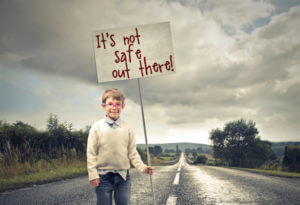Fear mongering
It can ruin or even prevent a vacation. It keeps some people from leaving the house.
An interesting debate, so let’s test this with a more recent event:
The 14 March 2015 intentional crashing of a Germanwings airplane into the Alps.
Afterwards, European Aviation Security Agency (AESA) called to have two pilots in the cockpit at all times – a direct result of the 14 March incident.
The pilot’s union for Lufthansa (parent company of Germanwings) is rejecting the request; calling the recommendations, “Counter productive”, and indicating that the, “…presumed security benefits do not outweigh the increased risks”.
The question
Are the imposed measures needed or is the request reactionary? Are airplanes going to start dropping out of the sky all the time now because of suicidal pilots?
No, and here’s why
According to IATA’s 2013 statistics, only one in 2.4 million planes have an accident each year, that means you have a .000000417% chance of being in an airplane crash. However, because you see it all over the news, you have the distinct impression that this is another possibility that makes flying less safe.
Bonus trivia: Pilot suicides account for less than 1% of all airplane crashes. Which means that intentional accidents are less than 1% of .000000417%… I think you’re safe.
As discussed in our review of Gavin DeBecker’s “Gift of Fear”, fear is a useful tool that has kept humans alive for a long, long time.
In “The Science of Fear” Daniel Gardner takes a deep dive into the science behind why our brains react the way they do and discusses how the news and advertisers use fear to manipulate our brain grapes. The book itself gets quite chewy with examples of experiments demonstrating various heuristics and biases and the foundations of why we react to specific events the way we do. For our purposes, I will highlight a few points that could help you get off the couch this year and/or completely change your vacation for the better.
Know thy enemy
You can protect yourself by understanding how these two terms affect your decision making:
1. Confirmation bias: If you think you’re right about something you will ignore the counter evidence and seek out information that confirms your beliefs. Basically you’ve got your blinders on, which means you really have to go out of your way to honestly balance your opinions based on evidence which indicates you could be wrong.
If you’re the type that loves social psychology (this guy), then I definitely recommend giving this book a read in a “Know thy enemy” type defense of all the messages that are constantly bombarding your brain grapes every day.




Fear is one of those nebulous things. It’s so frustrating to me that it’s marketed and the majority of people buy in… when the science is so clearly on our side. The world is a safe place. Travel is a safe activity. The “bad guys” are the vast, vast minority. Thanks for the book review… I’ll look it up!
Fantastic response – I couldn’t have said it any better!